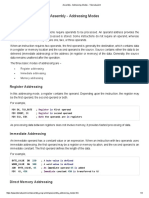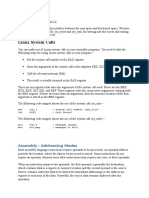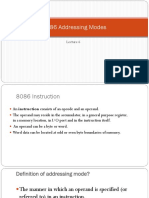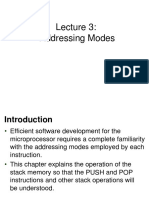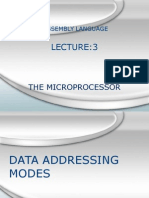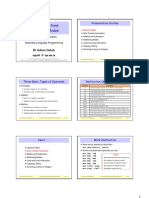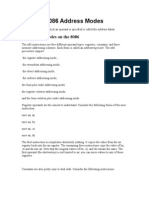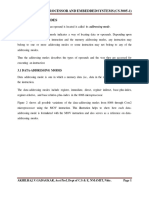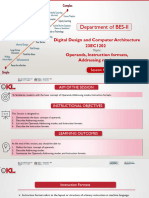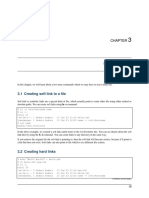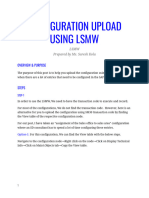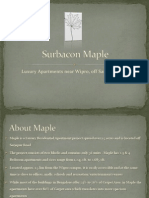6/15/24, 3:48 PM Assembly - Addressing Modes
Assembly - Addressing Modes
Most assembly language instructions require operands to be processed. An operand
address provides the location, where the data to be processed is stored. Some
instructions do not require an operand, whereas some other instructions may require
one, two, or three operands.
When an instruction requires two operands, the first operand is generally the
destination, which contains data in a register or memory location and the second
operand is the source. Source contains either the data to be delivered (immediate
addressing) or the address (in register or memory) of the data. Generally, the source
data remains unaltered after the operation.
The three basic modes of addressing are −
Register addressing
Immediate addressing
Memory addressing
Register Addressing
In this addressing mode, a register contains the operand. Depending upon the
instruction, the register may be the first operand, the second operand or both.
For example,
MOV DX, TAX_RATE ; Register in first operand
MOV COUNT, CX ; Register in second operand
MOV EAX, EBX ; Both the operands are in registers
As processing data between registers does not involve memory, it provides fastest
processing of data.
Immediate Addressing
An immediate operand has a constant value or an expression. When an instruction
with two operands uses immediate addressing, the first operand may be a register or
https://www.tutorialspoint.com/assembly_programming/assembly_addressing_modes.htm 1/5
�6/15/24, 3:48 PM Assembly - Addressing Modes
memory location, and the second operand is an immediate constant. The first
operand defines the length of the data.
For example,
BYTE_VALUE DB 150 ; A byte value is defined
WORD_VALUE DW 300 ; A word value is defined
ADD BYTE_VALUE, 65 ; An immediate operand 65 is added
MOV AX, 45H ; Immediate constant 45H is transferred to AX
Direct Memory Addressing
When operands are specified in memory addressing mode, direct access to main
memory, usually to the data segment, is required. This way of addressing results in
slower processing of data. To locate the exact location of data in memory, we need
the segment start address, which is typically found in the DS register and an offset
value. This offset value is also called effective address.
In direct addressing mode, the offset value is specified directly as part of the
instruction, usually indicated by the variable name. The assembler calculates the
offset value and maintains a symbol table, which stores the offset values of all the
variables used in the program.
In direct memory addressing, one of the operands refers to a memory location and
the other operand references a register.
For example,
ADD BYTE_VALUE, DL ; Adds the register in the memory location
MOV BX, WORD_VALUE ; Operand from the memory is added to register
Direct-Offset Addressing
This addressing mode uses the arithmetic operators to modify an address. For
example, look at the following definitions that define tables of data −
BYTE_TABLE DB 14, 15, 22, 45 ; Tables of bytes
WORD_TABLE DW 134, 345, 564, 123 ; Tables of words
The following operations access data from the tables in the memory into registers −
https://www.tutorialspoint.com/assembly_programming/assembly_addressing_modes.htm 2/5
�6/15/24, 3:48 PM Assembly - Addressing Modes
MOV CL, BYTE_TABLE[2] ; Gets the 3rd element of the BYTE_TABLE
MOV CL, BYTE_TABLE + 2 ; Gets the 3rd element of the BYTE_TABLE
MOV CX, WORD_TABLE[3] ; Gets the 4th element of the WORD_TABLE
MOV CX, WORD_TABLE + 3 ; Gets the 4th element of the WORD_TABLE
Indirect Memory Addressing
This addressing mode utilizes the computer's ability of Segment:Offset addressing.
Generally, the base registers EBX, EBP (or BX, BP) and the index registers (DI, SI),
coded within square brackets for memory references, are used for this purpose.
Indirect addressing is generally used for variables containing several elements like,
arrays. Starting address of the array is stored in, say, the EBX register.
The following code snippet shows how to access different elements of the variable.
MY_TABLE TIMES 10 DW 0 ; Allocates 10 words (2 bytes) each initialized to 0
MOV EBX, [MY_TABLE] ; Effective Address of MY_TABLE in EBX
MOV [EBX], 110 ; MY_TABLE[0] = 110
ADD EBX, 2 ; EBX = EBX +2
MOV [EBX], 123 ; MY_TABLE[1] = 123
The MOV Instruction
We have already used the MOV instruction that is used for moving data from one
storage space to another. The MOV instruction takes two operands.
Syntax
The syntax of the MOV instruction is −
MOV destination, source
The MOV instruction may have one of the following five forms −
MOV register, register
MOV register, immediate
MOV memory, immediate
https://www.tutorialspoint.com/assembly_programming/assembly_addressing_modes.htm 3/5
�6/15/24, 3:48 PM Assembly - Addressing Modes
MOV register, memory
MOV memory, register
Please note that −
Both the operands in MOV operation should be of same size
The value of source operand remains unchanged
The MOV instruction causes ambiguity at times. For example, look at the statements
−
MOV EBX, [MY_TABLE] ; Effective Address of MY_TABLE in EBX
MOV [EBX], 110 ; MY_TABLE[0] = 110
It is not clear whether you want to move a byte equivalent or word equivalent of the
number 110. In such cases, it is wise to use a type specifier.
Following table shows some of the common type specifiers −
Type Specifier Bytes addressed
BYTE 1
WORD 2
DWORD 4
QWORD 8
TBYTE 10
Example
The following program illustrates some of the concepts discussed above. It stores a
name 'Zara Ali' in the data section of the memory, then changes its value to another
name 'Nuha Ali' programmatically and displays both the names.
section .text Live Demo
global _start ;must be declared for linker (ld)
_start: ;tell linker entry point
https://www.tutorialspoint.com/assembly_programming/assembly_addressing_modes.htm 4/5
�6/15/24, 3:48 PM Assembly - Addressing Modes
;writing the name 'Zara Ali'
mov edx,9 ;message length
mov ecx, name ;message to write
mov ebx,1 ;file descriptor (stdout)
mov eax,4 ;system call number (sys_write)
int 0x80 ;call kernel
mov [name], dword 'Nuha' ; Changed the name to Nuha Ali
;writing the name 'Nuha Ali'
mov edx,8 ;message length
mov ecx,name ;message to write
mov ebx,1 ;file descriptor (stdout)
mov eax,4 ;system call number (sys_write)
int 0x80 ;call kernel
mov eax,1 ;system call number (sys_exit)
int 0x80 ;call kernel
section .data
name db 'Zara Ali '
When the above code is compiled and executed, it produces the following result −
Zara Ali Nuha Ali
https://www.tutorialspoint.com/assembly_programming/assembly_addressing_modes.htm 5/5

